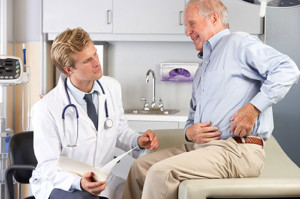 The process of identifying and treating health issues related to your hips often begins when you notice the pain that a hip problem produces. That pain can show up in the groin area, at the side of the hip, or with a snapping or popping of the hip when it is put in motion. Hip issues rarely manifest themselves in the buttocks. But what exactly are the causes of hip pain?
The process of identifying and treating health issues related to your hips often begins when you notice the pain that a hip problem produces. That pain can show up in the groin area, at the side of the hip, or with a snapping or popping of the hip when it is put in motion. Hip issues rarely manifest themselves in the buttocks. But what exactly are the causes of hip pain?
It’s important to distinguish hip issues from other causes of pain in the hip area, and very subtle differences viewed on an x-ray by a trained health professional can potentially have very large implications. One telltale sign is sometimes referred to as the “c-sign,” or crossover sign of joint rotation.
Anatomy of the hip
Simply put, your hip is a ball and socket joint. The ball exists on the top end of the femur bone in your leg, while the socket is called the acetabulum and is connected to your pelvis. There is also articular cartilage on the surfaces of the joint, along with more cartilage, called the acetabular labrum, around the rim of the socket to help it grip the ball.
Issues with hip cartilage
One of the most common hip issues results from a tear in that gripping cartilage. Labral tears are often caused by injuries or degeneration from other joint conditions, and they contribute to the femoral ball locking or “catching” in your joint. Typically an MRI scan with a dye injection is needed to confirm the diagnosis of a labral tear.
Hip impingement
Another common issue is a hip impingement, which occurs when there is a lack of room between the ball and socket. When this happens, the femur and acetabulum rub together. The resulting pain is often aggravated by more strenuous activity, though prolonged stationary sitting may also intensify pain. Because of the hip’s role in exercise, hip impingement is more common in athletic men.
Other types of hip impingement include a pincer, when there is excessive growth around the acetabulum that contributes to the rubbing, and a cam, when the neck of the femur is abnormally shaped and thus causes rubbing.
Getting a hip evaluation
A physician’s evaluation of the specific factors involved in your specific hip-area pain, as evidenced by the symptoms you are experiencing, is an important contribution to the determination of which of these hip issues is the cause of the trouble. That evaluation often begins with a discussion with your doctor about the total history of your hip pain, including the specific locations of the pain and the factors or instances that seem to cause the pain to flare up or become more noticeable both recently and at other times in the past. This is because hip issues can develop from previous injuries that may not have caused ongoing pain initially but created damage in your joint that increased the rate of deterioration and sped up the arrival of that ongoing pain. In other cases, excessive body weight can put additional stress on your joints and speed up the normal wear and tear on them, which also hastens interior joint deterioration and the arrival of chronic joint pain.
From that practical discussion of your health history, a physical exam is necessary to explore the extent of the range of motion in your hip joints, test for signs of impingement, and check for tenderness in the areas around your hip. The trained eye of your physician knows what to look for and realizes the implications of each subtle sign and symptom, but there are limits to the knowledge that can be ascertained.
That’s why x-rays are a next step, to provide a glimpse of the inner workings of your joint, and images are usually captured from several vantage points: the front (anterior), the back (posterior), and the side (lateral). Your doctor may even be interested in a fluoroscopy, which is basically an x-ray movie that provides a visual, moving model of how the many different parts of your joint work together.
Your hip evaluation may also extend beyond the exam room with a trial regimen of physical therapy or the prescription of non-steroidal anti-inflammatory drugs (NSAIDs) to determine the extent of damage or the impact of the pain on your quality of life. A little light, low-impact exercise can actually help alleviate your pain, because it triggers your brain to launch pain-reducing endorphins into your blood stream, helps rebuild muscles that can better protect your joints, and even contributes to the creation of stronger bones.
If the hip issue is more serious or doesn’t respond well to these non-invasive options, a referral to an orthopedic specialist may be necessary to explore other treatments like surgical operations that can better address your hip issues.





